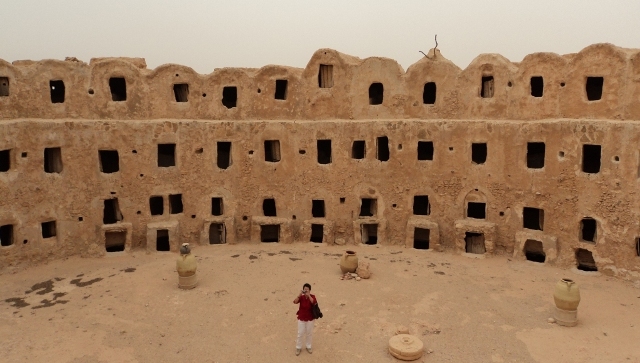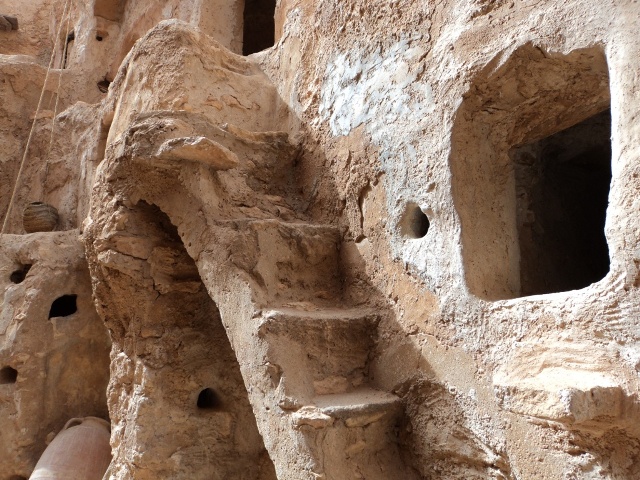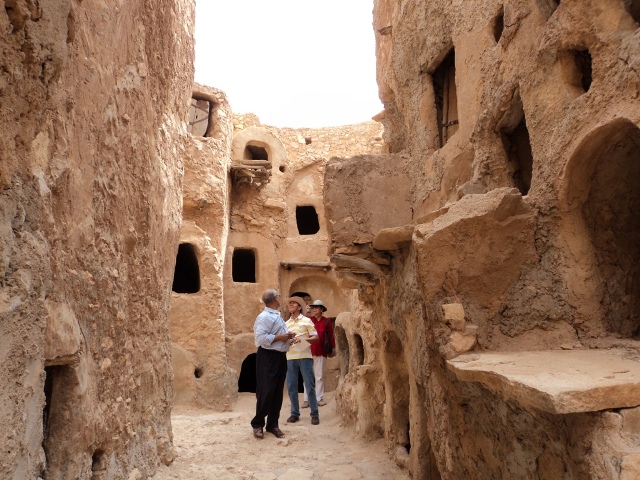Filtered By: Lifestyle
Lifestyle
Jewels of the Jebel Nafusa in Libya
Text & photos by ALICE SUN-CUA
Western Mountains, Libya My husband Alex, friend Al, and I were up early one Thursday morning, eager to be on the road for our trip through the Libyan Desert. Our guide, Mr. Taher Shogum, promised to show us the Berber heartland in the Western Mountains, or Jebel Nafusa, and it would mean a long drive from the capital Tripoli. After two hours we were out of the city, and the landscape changed. From shop-lined streets, residential houses built close together, and bustling lanes, the path opened out into wide spaces. The roads remained smooth and well-paved, but on both sides we started to see sandy areas where the only interesting things to see were camels driven by their turbaned owners (mostly Tuaregs, a nomadic tribe in Africa), and tall electric posts. Libya is, after all, about 80 per cent Sahara desert. Most of the urban areas are concentrated along the Mediterranean coast, in the northern part of the country. On and on our van went, until we reached a hilly place with a quaint sand-colored structure. It stood in the middle of what looked like an abandoned town, with its clusters of small sand huts and its own mosque made of the same material. Even the stones had the same hue – light ochre, and with the sun shining, everything looked like dark gold. Taher was smiling as he led us forward, and dramatically extended his right hand towards the open entrance of a domed enclosure. We looked at each other, ducked warily, and initially noted an exhibit of farming implements in a big niche carved into the wall. We walked further in, and made a collective gasp, stunned at the sight that greeted us inside the enclosed space. At first they looked like open catacombs stacked one on top of another. On second glance, they resembled dark, yawning square mouths of some extra-terrestrial beings. The structure was three stories high, each level lined up against each other in an orderly manner. Taher stood silently with his impish smile, letting us get our fill (and feel!) of the place. This, Taher said, was called Qasr Al Haj, a typical Berber monument. Qasr was an Arabic word that meant “castle,” and haj meant a pilgrimage. The haj is the annual pilgrimage done by Muslims to Mecca, a trip that has to be done at least once in this lifetime and one of the pillars (commandments) of Islam. During the 12th century, the Qasr Al Haj was a place where people who went on the haj stored their things before they go –think modern airport locker rooms – so they won’t be weighed down with too many things during their trip –either to nearby places, or to Arabia. A rich pilgrim thought of building this qasr to help his fellow religious travelers, thus it was named Qasr Al Haj (The Pilgrims’ Castle). During later times, the village that sprung in the area used the structure as storage rooms.  Qasrs were later used (even as late as the 1960s) as communal granary and olive oil storage rooms, because the villagers’ houses did not have enough spaces for these staples. There were oases nearby where grains were cultivated for food. Not everything could be consumed, hence the need for a place to store them. Each villager had a space in that qasr, and every week, someone who held a key to the spaces –think modern day safety deposit boxes but this time room-sized– opened the doors so the owners could get their food for that week. Around the Qasr Al Haj were farming implements and oil-pressing tools, and Taher patiently translated the Arabic descriptions and explanations in one of the wall recesses. Thick, coiled raffia ropes lay beside one of the presses, and our guide explained that these were used as sponges as the oil was pressed out, the liquid contents later squeezed out carefully into clay jars. It was not easy negotiating the second and third tiers of the qasr: it was for the sure-footed, what with the stone and sand stairs (or walk) simply carved out of the 90 degree walls. Alex and Al nimbly strode up the sides of the qasrs to take a look at the spaces on the topmost areas, while I contented myself with gazing at the lowermost rooms. There were old oil jars in some, but most of the rooms were empty. Some of them still had doors made of palm wood slats to protect their contents.
Qasrs were later used (even as late as the 1960s) as communal granary and olive oil storage rooms, because the villagers’ houses did not have enough spaces for these staples. There were oases nearby where grains were cultivated for food. Not everything could be consumed, hence the need for a place to store them. Each villager had a space in that qasr, and every week, someone who held a key to the spaces –think modern day safety deposit boxes but this time room-sized– opened the doors so the owners could get their food for that week. Around the Qasr Al Haj were farming implements and oil-pressing tools, and Taher patiently translated the Arabic descriptions and explanations in one of the wall recesses. Thick, coiled raffia ropes lay beside one of the presses, and our guide explained that these were used as sponges as the oil was pressed out, the liquid contents later squeezed out carefully into clay jars. It was not easy negotiating the second and third tiers of the qasr: it was for the sure-footed, what with the stone and sand stairs (or walk) simply carved out of the 90 degree walls. Alex and Al nimbly strode up the sides of the qasrs to take a look at the spaces on the topmost areas, while I contented myself with gazing at the lowermost rooms. There were old oil jars in some, but most of the rooms were empty. Some of them still had doors made of palm wood slats to protect their contents.  Berber Culture was nowhere more alive and practiced than in the areas around the Western Mountains, or the Jebel Nafusa in northwestern Libya. It was here, our guide related, during the Arab invasion of the 7th century that the Berbers retreated; even now authentic Berber architecture and cultural remnants could be seen in these seemingly inhospitable desert sands. Another interesting qasr was the Qasr Kabaw, a hilltop village fort, in the area of Nalut, which was the westernmost end of the Jebel Nafusa. It too, was made of a tall circular enclosure three stories high, with rooms for the storage of wheat and oil. Again, there were those huge empty doorways studding the façade of the granaries. Unlike those of Qasr Al Haj however, these ones seemed more intricate, with secret passageways and niches in between the buildings. There were tree and wooden limbs sticking out from the walls of each “cell,” perhaps a faster way of going up for those nimble of hands and feet. Further on, we got down in one of the narrow streets of Nalut, a preserved old town where we marveled at the twisting and narrow streets in between qasrs, with strange rock and stone formations around the area. From one of the high perches we could see the rocky promontories, the huge escarpment of lime and sand and desert, as far as the eye could see. The word that came to mind was “desolate,” what with such a huge swathe of desert sand, and the strong wind that could easily pick you up and fling you to the far reaches of the endless sandy expanse. The infinite vastness of the Sahara Desert made one pause, and contemplate the strange and breathless wonders of the natural world. Standing on that wind-swept promontory, one was indeed faced with the reality of how small and minute we really were, with our petty (and pesky) day-to-day preoccupations.
Berber Culture was nowhere more alive and practiced than in the areas around the Western Mountains, or the Jebel Nafusa in northwestern Libya. It was here, our guide related, during the Arab invasion of the 7th century that the Berbers retreated; even now authentic Berber architecture and cultural remnants could be seen in these seemingly inhospitable desert sands. Another interesting qasr was the Qasr Kabaw, a hilltop village fort, in the area of Nalut, which was the westernmost end of the Jebel Nafusa. It too, was made of a tall circular enclosure three stories high, with rooms for the storage of wheat and oil. Again, there were those huge empty doorways studding the façade of the granaries. Unlike those of Qasr Al Haj however, these ones seemed more intricate, with secret passageways and niches in between the buildings. There were tree and wooden limbs sticking out from the walls of each “cell,” perhaps a faster way of going up for those nimble of hands and feet. Further on, we got down in one of the narrow streets of Nalut, a preserved old town where we marveled at the twisting and narrow streets in between qasrs, with strange rock and stone formations around the area. From one of the high perches we could see the rocky promontories, the huge escarpment of lime and sand and desert, as far as the eye could see. The word that came to mind was “desolate,” what with such a huge swathe of desert sand, and the strong wind that could easily pick you up and fling you to the far reaches of the endless sandy expanse. The infinite vastness of the Sahara Desert made one pause, and contemplate the strange and breathless wonders of the natural world. Standing on that wind-swept promontory, one was indeed faced with the reality of how small and minute we really were, with our petty (and pesky) day-to-day preoccupations.  After a long stretch of driving eastward through sand and sky, we stopped at Gharyan to see a well-preserved dammous, or Berber House. Typically, a dammous is an underground house dug unto the earth three stories deep. This was mainly to protect the inhabitants from the extreme weather, both hot and cold, during changes of the seasons, and also against enemy sieges. From above it looked like a circular pit with low walls surrounding it. Looking down one could discern a small garden with palm trees right under the open-air opening about 10 meters wide. We went down a small tunnel and made our way into a well-appointed living room with lush carpets, and several living rooms with plush sofas and chairs all lavishly done in different colors and hues. This was just one of the beautifully-decorated rooms in the Berber dammous, and as Alex, Al, Taher, Haire and I went around we couldn’t help but exclaim at the beautiful carpets, the authentic looms, the tapestries. Everything seemed like a page from the Arabian tale of “A Thousand and One Nights.” Most of the rooms had “private quarters” in them – a recess in one of the corners partitioned off with heavy multi-hued curtains. These areas were for the married couple, while the more open spaces were for the children, the kitchen, and storage areas. We were told that as many as six families could live in this dammous at one time. The common courtyard was airy and cool, and several lounging chairs were strewn about, inviting everyone to sit and relax. En route back to Tripoli, Taher was teaching us a few Arabic phrases, and the one that stayed with me most was “Alham dulillah,” especially because of its song-like cadence. It could be conceptually translated us, “I’m fine, thanks to Allah!” Indeed, not unlike our “Mabuti naman, salamat sa Diyos!” One of the more popular ones was “Inshallah!” (If Allah wills it) Alex, Al and I were saying it aloud from time to time, and when Taher asked us, are we coming back next year for the one-week Sahara Akakus Tour? We enthusiastically chorused, “Inshallah, inshallah!” - YA, GMA News
After a long stretch of driving eastward through sand and sky, we stopped at Gharyan to see a well-preserved dammous, or Berber House. Typically, a dammous is an underground house dug unto the earth three stories deep. This was mainly to protect the inhabitants from the extreme weather, both hot and cold, during changes of the seasons, and also against enemy sieges. From above it looked like a circular pit with low walls surrounding it. Looking down one could discern a small garden with palm trees right under the open-air opening about 10 meters wide. We went down a small tunnel and made our way into a well-appointed living room with lush carpets, and several living rooms with plush sofas and chairs all lavishly done in different colors and hues. This was just one of the beautifully-decorated rooms in the Berber dammous, and as Alex, Al, Taher, Haire and I went around we couldn’t help but exclaim at the beautiful carpets, the authentic looms, the tapestries. Everything seemed like a page from the Arabian tale of “A Thousand and One Nights.” Most of the rooms had “private quarters” in them – a recess in one of the corners partitioned off with heavy multi-hued curtains. These areas were for the married couple, while the more open spaces were for the children, the kitchen, and storage areas. We were told that as many as six families could live in this dammous at one time. The common courtyard was airy and cool, and several lounging chairs were strewn about, inviting everyone to sit and relax. En route back to Tripoli, Taher was teaching us a few Arabic phrases, and the one that stayed with me most was “Alham dulillah,” especially because of its song-like cadence. It could be conceptually translated us, “I’m fine, thanks to Allah!” Indeed, not unlike our “Mabuti naman, salamat sa Diyos!” One of the more popular ones was “Inshallah!” (If Allah wills it) Alex, Al and I were saying it aloud from time to time, and when Taher asked us, are we coming back next year for the one-week Sahara Akakus Tour? We enthusiastically chorused, “Inshallah, inshallah!” - YA, GMA News
More Videos
Most Popular




